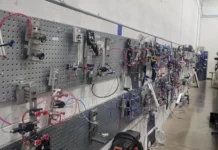by Brittany Willes, Plastics Business

In his book, “2 Second Lean: How to Grow People and Build a Lean Culture,” Akers discusses his conversion to lean manufacturing, highlighting several tactics he has used to encourage continuous improvement. He provides a quick “lean” summary of each chapter’s main points and take-away ideas. Additionally, at the end of each chapter, Akers provides brief worksheets and questionnaires designed to help readers identify areas of waste and potential improvement.
Furthermore, Akers emphasizes the importance of building a lean culture as the biggest key to successful lean manufacturing. He explains how his company started hosting morning meetings as a way of getting all employees involved. Every day, before production began, management committed to going over the previous day’s efforts by reading aloud daily sales, reviewing any mistakes made and encouraging discussion on how best to prevent mistakes in the future. Finally, they would review newly introduced processes and evaluate their effectiveness. Team members also became team leaders as they took turns leading morning meetings. According to Akers, “This is the beginning of how we built a culture of continuous improvement. We build leaders every day at FastCap.”
Akers’ book concludes with additional resources, including sample agendas for morning meetings, company/employee goals and further suggestions for building lean culture.
Business gurus often talk about the view from 30,000 feet – the big picture that provides a look at overall operations. Perhaps, however, the focus should be on the view from 30 feet – a close-up of specific processes and procedures that make an impact now.
In the last several years, lean manufacturing has spread rapidly throughout service and manufacturing industries such as aerospace, automotive, electronics and health care. Lean has served as a core business strategy, creating a competitive advantage by emphasizing elimination of non-value-added activities (waste), while delivering quality products with greater efficiency at the least cost.
Hansen Plastics Corporation, Elgin, Illinois, began seriously implementing the tools and methods of lean manufacturing in October 2013 following a MAPP conference where Paul Akers, author of “2 Second Lean,” detailed his own company’s positive experiences with lean. “We had been conscious of lean for about 10 years,” said Tim Bayer, president of Hansen. “We had used some of the tools here and there; however, it wasn’t until MAPP – and Paul – that we began to understand more about lean culture. In fact, culture is the true lean process.
“We started with communication and commitment,” Bayer further explained. “We scheduled daily 15-minute meetings for each shift where we would go over our sales, any issues or concerns, education about waste and suggestions for improvements.” The company’s commitment to education and improvement included reading from an educational book for a few minutes every day, watching videos every day and recognizing employees’ efforts. “Every day, we recognize improvements that employees have made, and we clap for them,” said Bayer. “They deserve to be recognized and doing so helps to further build lean culture.”
Along with their improvement efforts, employees are recognized for upholding the core company values of respect, honesty, gratitude, humility, knowledge and diversity. Bayer stated that while the company always had followed the values established by founder Elmer Hansen, those values had never been formally documented. As part of the shifting culture, each day employees would pick a core value and show how it was being met using lean methods.
Despite the company’s initial commitment to lean, the transition was not necessarily a smooth one. In the beginning, Hansen employees viewed lean as a passing fad – something they would talk about for a few weeks before it went away. When it became clear that lean was there to stay, employees in turn worried about how it would affect their jobs. “We had to make sure they knew they weren’t working themselves out of a job,” Bayer explained. “They needed the security to know the company was not eliminating jobs. It was cultivating jobs. With lean, the goal was to eliminate waste in order reinvest those resources into the company. Since 1971, we’ve never had a layoff. Being 100-percent employee-owned, we never want to have a layoff.”
Over time, Hansen employees have seen the positive effects of lean and embraced the company’s commitment to continuous improvement. “Lean is hard. It’s not for everyone,” said Bayer. “It’s a mindset, and you have to be passionate about it. It’s not going to work if you just like the idea. I’m incredibly proud of our people – of how much they’ve learned and grown and taken control of it. That’s one of the best things to come out of this whole process.”
According to Bayer, lean has allowed the company to create a more diverse and inclusive culture. Employees of all shifts have gotten to know each other better. Instead of having segregation between shifts, they now recognize one another. There is a sense of continuity throughout the company that extends even to new hires. “When someone starts here, we send a package to their house with Paul’s book so they know right away what we’re about and how we operate,” said Bayer. “We still do his videos every day. We feel like Paul is our best friend, even though we’ve never met him.”
Lean is very difficult, if not impossible, for those who are unable to handle change. Knowledge, one of Hansen’s core values, is perhaps the most important part of performing lean successfully. “You have to have a passion for knowledge,” stressed Bayer. “You have to be willing to learn more every day, to ask questions every day and to change your thinking. I love bragging about what everyone at Hansen has accomplished. They’ve done some amazing things. The whole-heartedness that has come out of this process really has brought people together.”
About “2 Second Lean”
Paul Akers had years of experience in manufacturing when he started his own product manufacturing business in 1997. Thus, it came as a shock when a consultant he’d hired to help manage the company’s inventory told Akers he didn’t know what he was doing. This moment marked the beginning of Akers’ lean journey, during which he would come to embrace the foundational lean principles of eliminating waste and continuous improvement.




